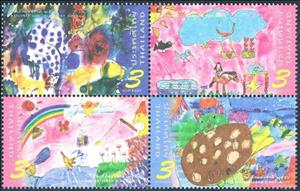Se-tenant: National Children's Day (Thailand 2007)
National Children's Day (Thailand 2007)
13 January (Thailand ) within release National Children's Day 2007 goes into circulation Se-tenant National Children's Day face value 4*3 Thai baht
| Se-tenant National Children's Day in catalogues | |
|---|---|
| Michel: | Mi: TH 2486-2489 |
| Yvert et Tellier: | Yt: TH 2347-2350 |
Se-tenant is square format.
Sn: TH 2270 Yt: TH 2347-2350 [but stamp order is not clear, the lower right in this image is #2347]Also in the issue National Children's Day 2007:
- Se-tenant - National Children's Day face value 4*3;
- Full Pane - National Children's Day face value 20*3;
Se-tenant National Children's Day it reflects the thematic directions:
Butterflies are insects in the macrolepidopteran clade Rhopalocera from the order Lepidoptera, which also includes moths. Adult butterflies have large, often brightly coloured wings, and conspicuous, fluttering flight. The group comprises the large superfamily Papilionoidea, which contains at least one former group, the skippers (formerly the superfamily "Hesperioidea") and the most recent analyses suggest it also contains the moth-butterflies (formerly the superfamily "Hedyloidea"). Butterfly fossils date to the Paleocene, which was about 56 million years ago. Butterflies have the typical four-stage insect life cycle. Winged adults lay eggs on the food plant on which their larvae, known as caterpillars, will feed. The caterpillars grow, sometimes very rapidly, and when fully developed, pupate in a chrysalis. When metamorphosis is complete, the pupal skin splits, the adult insect climbs out, and after its wings have expanded and dried, it flies off. Some butterflies, especially in the tropics, have several generations in a year, while others have a single generation, and a few in cold locations may take several years to pass through their whole life cycle. Butterflies are often polymorphic, and many species make use of camouflage, mimicry and aposematism to evade their predators. Some, like the monarch and the painted lady, migrate over long distances. Many butterflies are attacked by parasites or parasitoids, including wasps, protozoans, flies, and other invertebrates, or are preyed upon by other organisms. Some species are pests because in their larval stages they can damage domestic crops or trees; other species are agents of pollination of some plants. Larvae of a few butterflies (e.g., harvesters) eat harmful insects, and a few are predators of ants, while others live as mutualists in association with ants. Culturally, butterflies are a popular motif in the visual and literary arts.
Drawing is a visual art that uses an instrument to mark paper or another two-dimensional surface. The instrument might be pencils, crayons, pens with inks, brushes with paints, or combinations of these, and in more modern times, computer styluses with graphics tablets.


